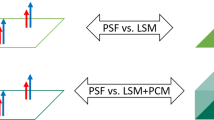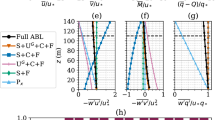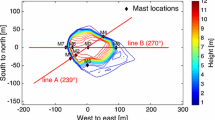Abstract
We use the mesoscale meteorological model Meso-NH, taking the drag force of trees into account under stable, unstable and neutral conditions in a real case study. Large-eddy simulations (LES) are carried out for real orography, using a regional forcing model and including the energy and water fluxes between the surface (mostly grass with some hedges of trees) and the atmosphere calculated using a state-of-the-art soil-vegetation-atmosphere-transfer model. The formulation of the drag approach consists of adding drag terms to the momentum equation and subgrid turbulent kinetic energy dissipation, as a function of the foliage density. Its implementation in Meso-NH is validated using Advanced Regional Prediction System simulation results and measurements from Shaw and Schumann (Boundary-Layer Meteorol, 61(1):47–64, 1992). The simulation shows that the Meso-NH model successfully reproduces the flow within and above homogeneous covers. Then, real case studies are used in order to investigate the three different boundary layers in a LES configuration (resolution down to 2 m) over the “Lannemezan 2005” experimental campaign. Thus, we show that the model is able to reproduce realistic flows in these particular cases and confirm that the drag force approach is more efficient than the classical roughness approach in describing the flow in the presence of vegetation at these resolutions.
Similar content being viewed by others
References
Aumond P, Gauvreau B, Lac C, Masson V, Bérengier M (2012) Numerical predictions for environmental acoustics: simulation of atmospheric fields and integration in a propagation model. Invited paper, Proc Acoustics 2012 (joint SFA/IOA international congress), Nantes (F), 23–27 April
Bohrer G, Katul GG, Walko R, Avissar R (2009) Exploring the effects of microscale structural heterogeneity of forest canopies using large-eddy simulations. Boundary-Layer Meteorol 132: 351–382
Bougeault P, Lacarrere P (1989) Parameterization of orography-induced turbulence in a mesobetascale model. Mon Weather Rev 117: 1872–1890
Büttner G, Feranec J, Jaffrain G, Mari L, Maucha G, Soukup T (2004) The CORINE land cover 2000 project. EARSeL eProc 3(3): 331–346
Cassiani M, Katul G, Albertson J (2008) The effects of canopy leaf area index on airflow across forest edges: large-eddy simulation and analytical results. Boundary-Layer Meteorol 126(3): 433–460
Chamecki M, Meneveau C, Parlange M (2009) Large eddy simulation of pollen transport in the atmospheric boundary layer. J Aerosol Sci 40(3): 241–255
Chow F, Weigel A, Street R, Rotach M, Xue M (2006) High-resolution large-eddy simulations of flow in a steep Alpine valley. Part I: Methodology, verification, and sensitivity experiments. J Appl Meteorol Climatol 45(1): 63–86
Cuxart J, Bougeault P, Redelsperger JL (2000a) A turbulence scheme allowing for mesoscale and large-eddy simulations. Q J R Meteorol Soc 126: 1–30
Cuxart J, Yague C, Morales G, Terradellas E, Orbe J, Calvo J, Fernández A, Soler M, Infante C, Buenestado P et al (2000b) Stable atmospheric boundary-layer experiment in Spain (SABLES 98): a report. Boundary-Layer Meteorol 96(3): 337–370
Deardorff J (1980) Stratocumulus-capped mixed layers derived from a three-dimensional model. Boundary-Layer Meteorol 18(4): 495–527
Déqué M, Dreveton C, Braun A, Cariolle D (1994) The ARPEGE/IFS atmosphere model: a contribution to the French community climate modelling. Clim Dyn 10: 249–270
Dupont S, Brunet Y (2008a) Edge flow and canopy structure: a large-eddy simulation study. Boundary-Layer Meteorol 126(1): 51–71
Dupont S, Brunet Y (2008b) Impact of forest edge shape on tree stability: a large-eddy simulation study. Forestry 81(3): 299
Dupont S, Brunet Y, Finnigan J (2008) Large-eddy simulation of turbulent flow over a forested hill: validation and coherent structure identification. Q J R Meteorol Soc 134(636): 1911–1929
Finnigan J (2000) Turbulence in plant canopies. J Fluid Mech 32(1): 519–571
Irvine M, Gardiner B, Hill M (1997) The evolution of turbulence across a forest edge. Boundary-Layer Meteorol 84(3): 467–496
Jiménez M, Cuxart J (2005) Large-eddy simulations of the stable boundary layer using the standard Kolmogorov theory: range of applicability. Boundary-Layer Meteorol 115(2): 241–261
Junker F, Gauvreau B, Bérengier M, Cremezi-Charlet C, Blanc-Benon P, Cotté B, Ecotière D (2006) Classification of relative influence of physical parameters for long range acoustic propagation. Invited paper to Internoise 2006, Honolulu (EUA), December
Kanda M, Hino M (1994) Organized structures in developing turbulent flow within and above a plant canopy, using a large eddy simulation. Boundary-Layer Meteorol 68(3): 237–257
Lafore J, Stein J, Asencio N, Bougeault P, Ducrocq V, Duron J, Fischer C, Hereil P, Mascart P, Pinty J, Redelsperger J, Richard E, de Arellano JVG (1998) The Meso-NH atmospheric simulation system. Part I: Adiabatic formulation and control simulations. Ann Geophys 16: 90–109
Masson V, Seity Y (2009) Including atmospheric layers in vegetation and urban offline surface schemes. J Appl Meteorol Climatol 48: 1377–1397
Mayhead G (1973) Some drag coefficients for British forest trees derived from wind tunnel studies. Agric Meteorol 12: 123–130
Noilhan J, Planton S (1989) A simple parameterization of land surface processes for meteorological models. Mon Weather Rev 117(3): 536–549
Otte T, Lacser A, Dupont S, Ching J (2004) Implementation of an urban canopy parameterization in a mesoscale meteorological model. J Appl Meteorol 43(11): 1648–1665
Patton E, Shaw R, Judd M, Raupach M (1998) Large-eddy simulation of windbreak flow. Boundary-Layer Meteorol 87(2): 275–307
Patton E, Sullivan P, Davis K (2003) The influence of a forest canopy on top-down and bottom-up diffusion in the planetary boundary layer. Q J R Meteorol Soc 129(590): 1415–1434
Pimont F, Dupuy J, Scarella G, Caraglio Y, Morvan D (2006) Effects of small scale heterogeneity of vegetation on radiative transfer in forest fire. For Ecol Manag 234: S88
Poggi D, Katul G (2010) Evaluation of the turbulent kinetic energy dissipation rate inside canopies by zero- and level-crossing density methods. Boundary-Layer Meteorol 136: 1–15
Poggi D, Katul G, Albertson J (2004) Momentum transfer and turbulent kinetic energy budgets within a dense model canopy. Boundary-Layer Meteorol 111(3): 589–614
Shaw R, Schumann U (1992) Large-eddy simulation of turbulent flow above and within a forest. Boundary-Layer Meteorol 61(1): 47–64
Shen S, Leclerc M (1997) Modelling the turbulence structure in the canopy layer. Agric For Meteorol 87(1): 3–25
Su H, Shaw R, Paw K, Moeng C, Sullivan P (1998) Turbulent statistics of neutrally stratified flow within and above a sparse forest from large-eddy simulation and field observations. Boundary-Layer Meteorol 88(3): 363–397
Tomas S, Masson V (2006) A parameterization of third-order moments for the dry convective boundary layer. Boundary-Layer Meteorol 120(3): 437–454
Weigel A, Chow F, Rotach M, Street R, Xue M (2006) High-resolution large-eddy simulations of flow in a steep Alpine valley. Part II: Flow structure and heat budgets. J Appl Meteorol Climatol 45(1): 87–107
Weigel A, Chow F, Rotach M (2007) On the nature of turbulent kinetic energy in a steep and narrow Alpine valley. Boundary-Layer Meteorol 123(1): 177–199
Author information
Authors and Affiliations
Corresponding author
Rights and permissions
About this article
Cite this article
Aumond, P., Masson, V., Lac, C. et al. Including the Drag Effects of Canopies: Real Case Large-Eddy Simulation Studies. Boundary-Layer Meteorol 146, 65–80 (2013). https://doi.org/10.1007/s10546-012-9758-x
Received:
Accepted:
Published:
Issue Date:
DOI: https://doi.org/10.1007/s10546-012-9758-x




